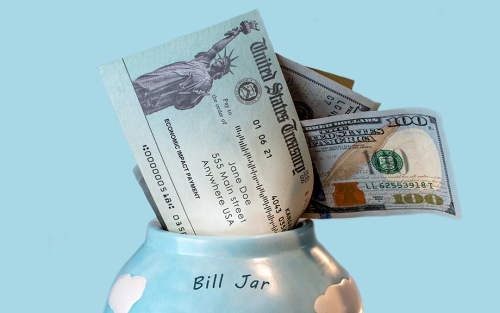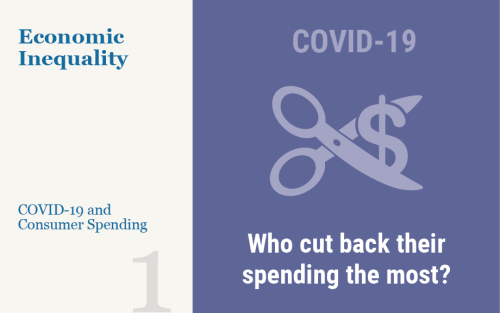Credit Card Balance Declines Are Largest Among Older, Wealthier Borrowers

Total household debt rose by $85 billion in the first quarter of 2021, according to the latest Quarterly Report on Household Debt and Credit from the New York Fed’s Center for Microeconomic Data. Since the start of the pandemic, household debt balances have increased in every quarter but one—the second quarter of 2020, when lockdowns were in full effect. The Quarterly Report and this analysis are based on the New York Fed’s Consumer Credit Panel, which is based on Equifax credit data.
Women’s Labor Force Participation Was Rising to Record Highs—Until the Pandemic Hit

Women’s labor force participation grew precipitously in the latter half of the 20th century, but by around the year 2000, that progress had stalled. In fact, the labor force participation rate for prime-age women (those aged 25 to 54) fell four percentage points between 2000 and 2015, breaking a decades-long trend. However, as the labor market gained traction in the aftermath of the Great Recession, more women were drawn into the labor force. In less than five years, between 2015 and early 2020, women’s labor force participation had recovered nearly all of the ground lost over the prior fifteen years. Then the pandemic hit, erasing these gains. In recent months, as the economy has begun to heal, women’s labor force participation has increased again, but there is much ground to be made up, especially for Black and Hispanic women. A strong labor market with rising wages, as was the case in the years leading up to the pandemic, will be instrumental in bringing more women back into the labor force.
Many Small Businesses in the Services Sector Are Unlikely to Reopen

The services sector was hit hard during the COVID-19 pandemic. Small businesses were particularly affected, and many of them were forced to close. We examine the state of these firms using micro data from Homebase (HB), a scheduling and time tracking tool that is used by around 100,000 businesses, mostly small firms, in the leisure and hospitality and retail industries. The data reveal that 35 percent of businesses that were active prior to the pandemic are still closed and that most have been inactive for twenty weeks or longer. We estimate that each additional week of being closed reduces the probability that a business reopens by 2 percentage points. Moreover, an additional week of business closure lowers the share of workers that are rehired at reopening. Our estimates imply that only about 4 percent of the workers that are still laid off from the currently closed businesses will eventually be rehired.
Endogenous Supply Chains, Productivity, and COVID‑19

During the COVID-19 pandemic, many industries adapted to new social distancing guidelines by adopting new technologies, providing protective equipment for their employees, and digitizing their methods of production. These changes in industries’ supply chains, together with monetary and fiscal stimulus, contributed to dampening the economic impact of COVID-19 over time. In this post, I discuss a new framework that analyzes how changes in supply chains can drive economic growth in the long run and mitigate recessions in the short run.
What Is behind the Global Jump in Personal Saving during the Pandemic?

Household saving has soared in the United States and other high-income countries during the COVID-19 pandemic, despite widespread declines in wages and other private income streams. This post highlights the role of fiscal policy in driving the saving boom, through stepped-up social benefits and other income support measures. Indeed, in the United States, Japan, and Canada, government assistance has pushed household income above its pre-pandemic trajectory. We argue that the larger scale of government assistance in these countries helps explain why saving in these countries has risen more strongly than in the euro area. Going forward, how freely households spend out of their newly accumulated savings will be a key factor determining the strength of economic recoveries.
How COVID‑19 Affected First‑Time Homebuyers

Efforts in the spring of 2020 to contain the spread of COVID-19 resulted in a sharp contraction in U.S. economic growth and an unprecedented, rapid rise in unemployment. While the first wave of the pandemic slowed the spring housing market, home sales rebounded sharply over the rest of the year, with strong gains in house prices. Given the rising house prices and continuing high unemployment, concerns arose that COVID-19 may have negatively affected first-time homebuyers. Using a new and more accurate measure of first-time homebuyers, we find that these buyers have not been adversely affected by the pandemic. At the same time, gains from lower mortgage rates have gone to existing homeowners and not to households purchasing their first home.
An Update on How Households Are Using Stimulus Checks

In October, we reported on how households used their first economic impact payments, which they started to receive in mid-April 2020 as part of the CARES Act, and how they expected to use a second stimulus payment. In this post, we exploit new survey data to examine how households used the second round of stimulus checks, abd we investigate how they plan to use the third round.
“Excess Savings” Are Not Excessive

How will the U.S. economy emerge from the ongoing COVID-19 pandemic? Will it struggle to return to prior levels of employment and activity, or will it come roaring back as soon as vaccinations are widespread and Americans feel comfortable travelling and eating out? Part of the answer to these questions hinges on what will happen to the large amount of “excess savings” that U.S. households have accumulated since last March. According to most estimates, these savings are around $1.6 trillion and counting. Some economists have expressed the concern that, if a considerable fraction of these accumulated funds is spent as soon as the economy re-opens, the ensuing rush of demand might be destabilizing. This post argues that these savings are not that excessive, when considered against the backdrop of the unprecedented government interventions adopted over the past year in support of households and that they are unlikely to generate a surge in demand post-pandemic.
Reasonable Seasonals? Seasonal Echoes in Economic Data after COVID‑19

Seasonal adjustment is a key statistical procedure underlying the creation of many economic series. Large economic shocks, such as the 2007-09 downturn, can generate lasting seasonal echoes in subsequent data. In this Liberty Street Economics post, we discuss the prospects for these echo effects after last year’s sharp economic contraction by focusing on the payroll employment series published by the U.S. Bureau of Labor Statistics (BLS). We note that seasonal echoes may lead the official numbers to overstate actual changes in payroll employment modestly between March and July of this year after which distortions flip the other way.















 RSS Feed
RSS Feed Follow Liberty Street Economics
Follow Liberty Street Economics